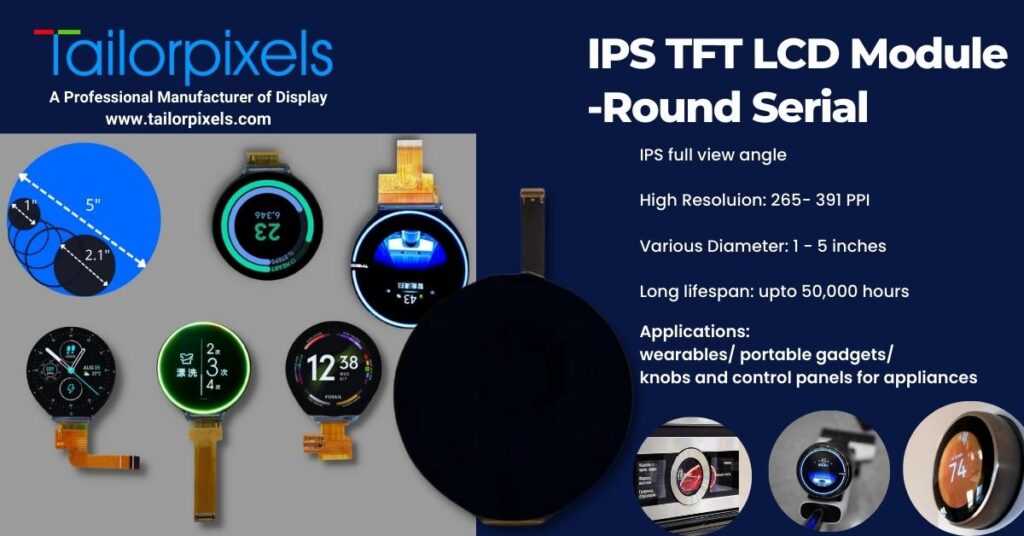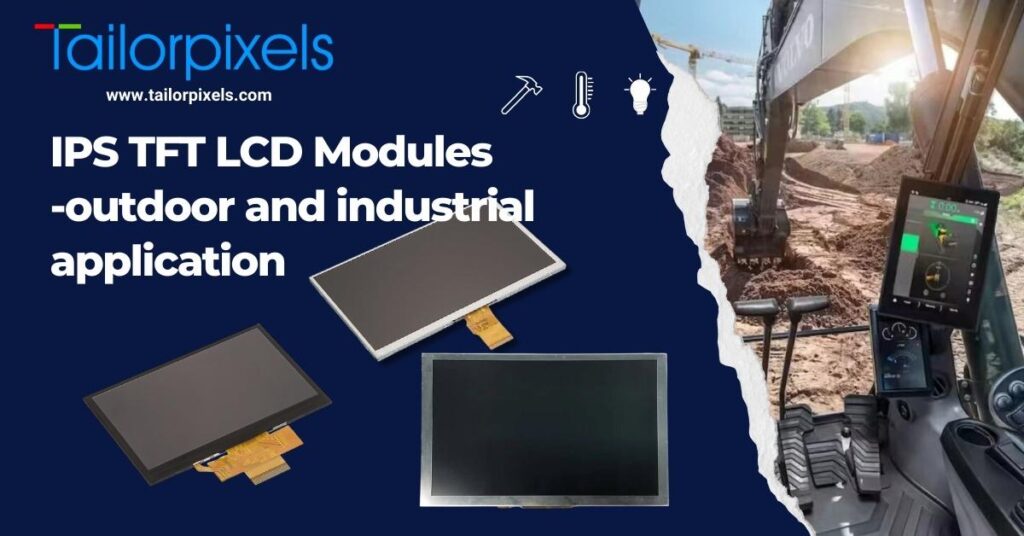TFT LCD Wide Viewing Angle Technologies:TN+Film vs. IPS
In the display revolution history, to replace the traditional CRT displays and become a mainstream display technology, thin-film liquid crystal displays (TFT LCD) has overcome a major disadvantage in viewing angle:
when you look at an LCD from a certain angle, you will notice a sudden loss (darkening) and discoloration of the display brightness. Older flat-panel displays typically have only a 90⁰ viewing angle, that is 45⁰ on each left/right side.
Since the principle of LCD is to control the spatial orientation of liquid crystal molecules through an electric field, and change the vibration direction of the incident light from the backlight source, that is to say, most of the light emitted from the screen is polarized light.
If we look at an all-white screen from a very oblique angle, we may see blacks or color distortion, which limits the viewing angle of the LCD (the maximum viewing angle is defined with a contrast ratio of at least 10:1, usually in up/down/left/right four directions).
LCD manufacturers have attempted to improve the viewing angle characteristics of LCD through various techniques, and several wide viewing angle techniques have been proposed.
TN+Film (Twisted Nematic+Film)
The most commonly used is the twisted nematic TFT liquid crystal display (Twisted Nematic TFT LCD). Its working principle is: there are polarizers on the upper and lower layers of the panel, the transmission directions of the two polarizers are perpendicular to each other. The liquid crystal molecules are spatially arranged in a 90° twist from the upper layer to the lower layer.
When power voltage is not applied, the liquid crystal is in a natural state, and the light emitted from the lower layer will be twisted by 90° after passing through the liquid crystal interlayer, so that it can smoothly pass through the upper layer.
When power voltage is applied between the two layers, an electric field will be generated. At this time, the liquid crystal will be deflected and arranged vertically, the light will not be twisted. Thereby the light can not pass through the lower layer.
In this way, the control of the pixels illuminated by the backlight is realized.
Since it is polarized light, the visible range is limited, generally around 90°. While the TN+Film technology adds a layer of wide-viewing angle compensation film on the surface of the panel to increase the viewing angle. From a technical point of view, this is an easy method to implement in wide viewing angle technologies.
LCD manufacturers use a more mature standard TFT Twisted Nematic liquid crystal. A special film (turning film) applied to the upper surface of the panel can increase the horizontal viewing angle from 90° to 140°degrees, which is the simplest method and has a high yield.
However, the two major problems of low contrast and slow response time still cannot be improved.
The easy way to identify the TN display is because of the principle of luminescence. The color shift characteristic of black-and-white inversion issues can be found in a large viewing angle range in the vertical direction. Since the twisted arrangement of the liquid crystal is easily disrupted, when the screen is pressed by an external force, there will be obvious brightness water pattern changes around the squeeze point.
IPS (In-Plane Switching or Super-TFT)
IPS (In-Plane Switching) was originally developed by Hitachi, but now it is a mature technology applied in many of the TFT-LCDs.

The same of IPS and TN+Film technology is through the twist of liquid crystal that the polarization direction of light changes, thus affecting the light transmission.
The difference is that the electrodes of the IPS are on the same side of the panel, the positive and negative electrodes are staggered, and the rotation of the liquid crystal molecules occurs in the horizontal direction. After the liquid crystal is twisted, the alignment direction is still parallel to the glass substrate.

Figure 1. Comparison of TN and IPS technologies
Due to the horizontal arrangement of liquid crystal molecules, using IPS or Super TFT technology can expand the viewing angle to more than 170°, just like the viewing angle of CRT monitors.
By comparing with TN, IPS also call the hard screen technology given its horizontal shift molecular arrangement providing a more robust and stable liquid crystal structure.
Advantages of IPS:
● Wide viewing angle
The viewing angle of the IPS panel can reach 178 degrees. As mentioned previously, the maximum viewing angle is defined with a contrast ratio of at least 10:1, usually in up/down/left/right four directions. Tests show that the color distortion obtained by the naked eyes from every angle toward the IPS screen is almost insignificant.
● Fast response
IPS technology changes the arrangement of liquid crystal molecules in horizontal conversion. Consequently, the response speed of the liquid crystal screen is faster and more stable. When handling moving images, it can speed up the deflection speed of LC molecules. The fast response speed of IPS screen makes the movement of the content more fine and clear and solves the problems of image smearing and shaking effects. When people enjoy long-time fast motion films, the display performance by the IPS screen is clear and smooth, which dramatically reduces the pain and tiredness of the eyes and is fully in line with health demands.
● True colors
IPS screen can provide excellent color inversion and brightness conversion, which shows images in vivid and natural colors.
● Touch without watermarks
The hard screen technology of IPS eliminates the problem of watermarks, shadows, and flashes when it is pressed, so it is most applicable for devices with a touchscreen display.
● Environmental friendly and power-saving
IPS technology has a breakthrough in energy-saving. The technology of horizontal alignment has reduced the thickness of the LC layer and changed the light transmittance of the liquid crystal screen. Besides, IPS adopts bipolar drive technology, which increases the pixel aperture ratio by 25%. Given the transmittance, to achieve the same brightness in the application, IPS can save more energy. On the other hand, even for a durable consumer product, like TV, the service life span of an IPS LCD can be more than 70,000 hours in theory.
● Size advantage
In terms of the size of the LCD screen, IPS also has obvious advantages compared to the old LCD screen. For example, the mainstream 42-inch and 40-inch panels on the market, the 42-inch LCD TV with hard screen technology has an area of 67.58 square inches more than the 40-inch LCD screen of the old LCD screen. This is not only a literal difference of 2 inches but a whole laptop. On the 42-inch screen, the screen of the digital TV can be fully displayed, so consumers can enjoy the game with a larger screen. The 40-inch screen is slightly inferior since the small parts on the corners cannot be displayed and the image cannot be restored completely.
Drawbacks of IPS
this technique also has drawbacks, because the electrodes can only be placed on one side of the two glass plates, and the electrodes must be arranged like a comb on the surface of a certain layer. This will reduce the contrast, so the backlight needs to be brightened.
Because of the influence of the level of processing technology, the aperture ratio of the electrode is also limited.
Moreover, under the effect of the wide viewing angle, there is a small amount of color deflection in the four corners of the display and a light leakage problem.
Comparison of two major techniques
TN+Film does not improve the response time much. This technology is relatively simple and has a high yield. It can only improve the viewing angle to an acceptable level for the human eye, so displays using this technology will gradually decline.
IPS has been adopted by several manufacturers, including Hitachi and NEC, which support this technology. The success of this technology is that it offers a 170° viewing angle and acceptable response speed.
| Feature | TN+Film | IPS |
| Viewing Angle | With a special film to widen the TN-LCD viewing angle. However,it can only improve viewing angle slightly | Wider viewing angles with no distortion in color in both horizontal and vertical directions. |
| Contrast | Lower and inferior image quality | The best contrast ratios and excellent management of black levels than many VA and TN panels |
| Response Time | Not much improve | Good |
| Cost | Lower | Higher than TN, but still have cost advantage than other technologies due to the mature in production |
| Application | Industrial application | Suitable for many applications requiring a high-visibility display image high resolution, and touch function. |

In addition to the above wide-view technologies, SHARP exclusive ASV technology, a deformation MVA technology “PVA” from South Korea SAMSUNG, and IPS deformation “FFS” technology owned by South Korea HYDIS.
With the emergence and introduction of various optimized technologies, the display effect of LCD will continue to be surpassed to meet various application requirements.
Tailor Pixels is a professional TFT-LCD manufacturer and supplier, providing standard and custom IPS TFT LCD products and solutions for different terminals.

